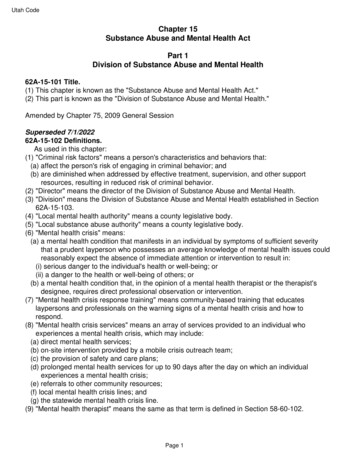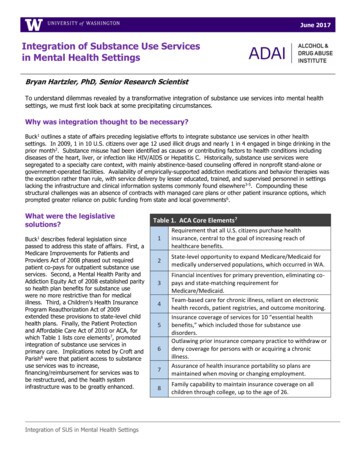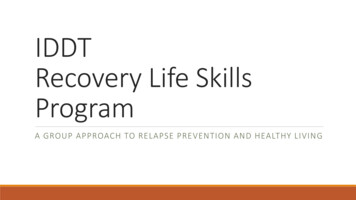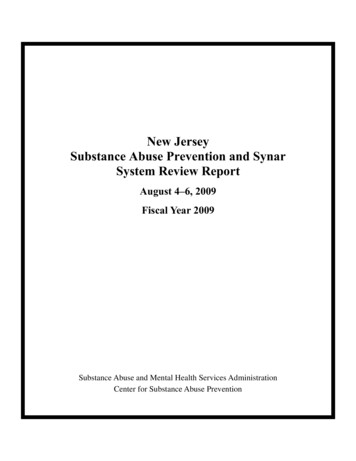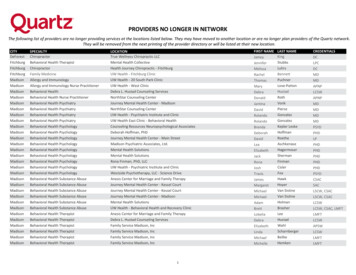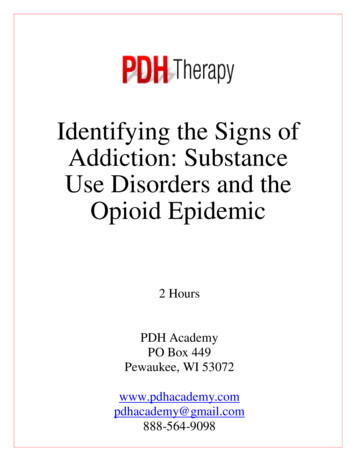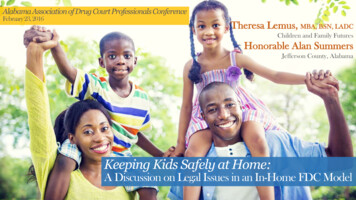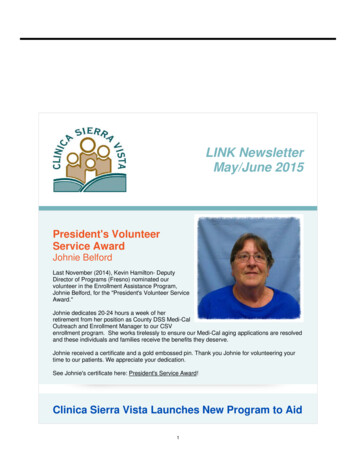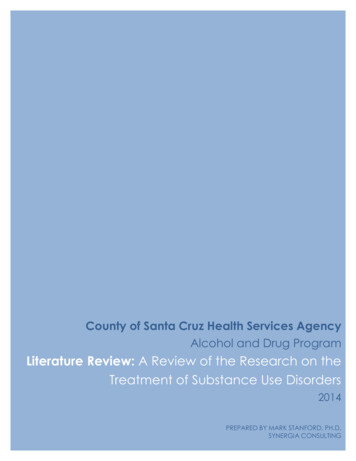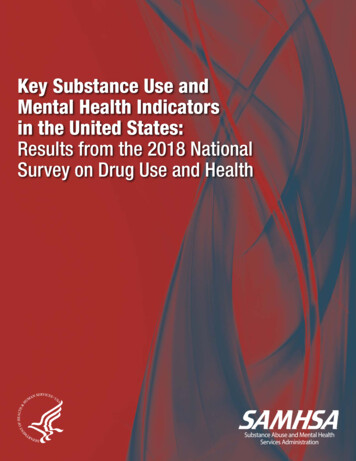
Transcription
Key Substance Use andMental Health Indicatorsin the United States:Results from the 2018 NationalSurvey on Drug Use and Health
Key Substance Use and Mental Health Indicators in the United States:Results from the 2018 National Survey on Drug Use and HealthAcknowledgmentsThis report was prepared for the Substance Abuse and Mental Health Services Administration (SAMHSA),U.S. Department of Health and Human Services (HHS), under Contract No. HHSS283201700002C withRTI International. Rachel N. Lipari and Eunice Park-Lee were the SAMHSA authors. Peter Tice served as thegovernment project officer and as the contracting officer representative.Public Domain NoticeAll material appearing in this report is in the public domain and may be reproduced or copied without permissionfrom SAMHSA. Citation of the source is appreciated. However, this publication may not be reproduced ordistributed for a fee without the specific, written authorization of the Office of Communications, SAMHSA, HHS.Electronic Access and Printed CopiesThis publication may be downloaded or ordered at https://store.samhsa.gov. Or call SAMHSA at1-877-SAMHSA-7 (1-877-726-4727) (English and Español).Recommended CitationSubstance Abuse and Mental Health Services Administration. (2019). Key substance use and mental healthindicators in the United States: Results from the 2018 National Survey on Drug Use and Health (HHS PublicationNo. PEP19-5068, NSDUH Series H-54). Rockville, MD: Center for Behavioral Health Statistics and Quality,Substance Abuse and Mental Health Services Administration. Retrieved from https://www.samhsa.gov/data/Originating OfficeCenter for Behavioral Health Statistics and Quality, Substance Abuse and Mental Health Services Administration,5600 Fishers Lane, Room 15-E09D, Rockville, MD 20857. For questions about this report, please n NoticeSAMHSA complies with applicable federal civil rights laws and does not discriminate on the basis of race, color,national origin, age, disability, or sex. SAMHSA cumple con las leyes federales de derechos civiles aplicables y nodiscrimina por motivos de raza, color, nacionalidad, edad, discapacidad o sexo.U.S. Department of Health and Human ServicesSubstance Abuse and Mental Health Services AdministrationCenter for Behavioral Health Statistics and QualityPopulations Survey BranchAugust 2019
Key Substance Use and Mental Health Indicators in the United States:Results from the 2018 National Survey on Drug Use and HealthAugust 2019 iiiTable of ContentsSummary 1Introduction 5Survey Background 5Data Presentation and Interpretation 5Substance Use in the Past Month 6Tobacco Use in the Past Month 7Cigarette Use 8Daily Cigarette Use 9Alcohol Use in the Past Month 10Any Alcohol Use 10Binge Alcohol Use 11Heavy Alcohol Use 11Illicit Drug Use in the Past Year 12Any Illicit Drug Use 12Marijuana Use 13Cocaine Use 14Heroin Use 15Methamphetamine Use 15Hallucinogen Use 16Inhalant Use 17Misuse of Psychotherapeutic Drugs 17Stimulant Misuse 18Tranquilizer or Sedative Misuse 18Benzodiazepine Misuse 19Pain Reliever Misuse 20Opioid Misuse 23Initiation of Substance Use 24Initiation of Cigarette Use 24Initiation of Alcohol Use 25Initiation of Marijuana Use 25Initiation of Cocaine Use 26Initiation of Heroin Use 26Initiation of Methamphetamine Use 27Initiation of Hallucinogen Use 27Initiation of Inhalant Use 28Initiation of Stimulant Misuse 28Initiation of Tranquilizer or Sedative Misuse 28Initiation of Pain Reliever Misuse 29Perceived Risk from Substance Use 30Perceived Risk from Substance Use among Adolescents 30Perceived Risk from Substance Use among Young Adults 31Perceived Risk from Substance Use among Adults Aged26 or Older 32Substance Use Disorders in the Past Year 32Alcohol Use Disorder 32Illicit Drug Use Disorder 33Marijuana Use Disorder 35Cocaine Use Disorder 35Heroin Use Disorder 36Methamphetamine Use Disorder 37Stimulant Use Disorder 37Tranquilizer Use Disorder or Sedative Use Disorder 38Pain Reliever Use Disorder 38Opioid Use Disorder 39Substance Use Disorder (Alcohol or Illicit Drugs) 39Major Depressive Episode in the Past Year 41MDE and MDE with Severe Impairment among Adolescents 41MDE and MDE with Severe Impairment among Adults 42Any Mental Illness among Adults in the Past Year 43Serious Mental Illness among Adults in the Past Year 43Co‑Occurring MDE and SUD among Adolescents 44Substance Use among Adolescents with MDE 45Co‑Occurring Mental Health Issues and SUD among Adults 45Co‑Occurring AMI and SUD 45Co‑Occurring SMI and SUD 46Substance Use among Adults with Mental Health Issues 47Suicidal Thoughts and Behavior among Adults 47Serious Thoughts of Suicide 48Suicide Plans 48Suicide Attempts 49Substance Use Treatment in the Past Year 50Need for Substance Use Treatment 50Receipt of Substance Use Treatment 50Perceived Need for Substance Use Treatment 53Reasons for Not Receiving Specialty Substance Use Treatment 54Mental Health Service Use in the Past Year 55Treatment for Depression among Adolescents 55Treatment for Depression among Adults 55Any Mental Health Service Use among All Adolescents 57Any Mental Health Service Use among All Adults 58Any Mental Health Service Use among Adults with AMI 59
iv August 2019Key Substance Use and Mental Health Indicators in the United States:Results from the 2018 National Survey on Drug Use and HealthAny Mental Health Service Use among Adults with SMI 60Perceived Unmet Need for Mental Health Servicesamong Adults with Mental Illness 61Receipt of Services for Co‑Occurring Substance UseDisorder and Mental Health Issues 63Receipt of Services among Adolescents withCo‑Occurring MDE and a Substance Use Disorder 63Receipt of Services among Adults with Co‑Occurring AMIand a Substance Use Disorder 64Receipt of Services among Adults with Co‑Occurring SMIand a Substance Use Disorder 65Endnotes 67Appendix A: Supplemental Tables of Estimates for KeySubstance Use and Mental Health Indicators in theUnited States A‑1
Key Substance Use and Mental Health Indicators in the United States:Results from the 2018 National Survey on Drug Use and HealthSummaryThis report summarizes key findings from the 2018 NationalSurvey on Drug Use and Health (NSDUH) for nationalindicators of substance use and mental health among peopleaged 12 or older in the civilian, noninstitutionalized populationof the United States. Results are provided for the overall categoryof people aged 12 or older and by age subgroups.Substance UseIn 2018, an estimated 164.8 million people aged 12 or olderin the United States (60.2 percent) were past month substanceusers (i.e., tobacco, alcohol, or illicit drugs). About 2 out of 5people aged 12 or older (108.9 million, or 39.8 percent) did notuse substances in the past month. The 164.8 million past monthsubstance users in 2018 include 139.8 million people who drankalcohol, 58.8 million people who used a tobacco product, and31.9 million people who used an illicit drug.Tobacco UseIn 2018, an estimated 47.0 million people aged 12 or olderwere past month cigarette smokers, including 27.3 millionpeople who were daily cigarette smokers and 10.8 milliondaily smokers who smoked approximately a pack or moreof cigarettes per day. Fewer than 1 in 6 people aged 12 orolder in 2018 were past month cigarette smokers. Cigaretteuse generally declined between 2002 and 2018 across allage groups. Some of this decline may reflect the use ofelectronic vaporizing devices (“vaping”), such as e-cigarettes,as a substitute for delivering nicotine. NSDUH does notcurrently ask separate questions about the vaping of nicotine.Alcohol UseIn 2018, about 139.8 million Americans aged 12 or olderwere past month alcohol users, 67.1 million were bingedrinkers in the past month, and 16.6 million were heavydrinkers in the past month.1 About 2.2 million adolescentsaged 12 to 17 drank alcohol in the past month, and1.2 million of these adolescents binge drank in that period.Although the percentage of adolescents who drank alcoholdecreased between 2002 and 2018, about 1 in 11 adolescentsin 2018 were past month alcohol users.1 NSDUHcollects information on past month alcohol use, binge alcohol use,and heavy alcohol use. For men, binge alcohol use is defined in NSDUH asdrinking five or more drinks on the same occasion on at least 1 day in thepast 30 days. For women, binge drinking is defined as drinking four or moredrinks on the same occasion on at least 1 day in the past 30 days. Heavyalcohol use is defined as binge drinking on 5 or more days in the past 30 days.August 2019 1Illicit Drug UseIn 2018, nearly 1 in 5 people aged 12 or older (19.4 percent)used an illicit drug in the past year, which is a higherpercentage than in 2015 and 2016. The estimate of past yearillicit drug use for 2018 was driven primarily by marijuanause, with 43.5 million past year marijuana users. Thepercentage of people aged 12 or older in 2018 who usedmarijuana in the past year (15.9 percent) was higher thanthe percentages in 2002 to 2017. This increase in past yearmarijuana use for people aged 12 or older reflects increasesin marijuana use among both young adults aged 18 to 25and adults aged 26 or older. In contrast, past year marijuanause among adolescents aged 12 to 17 did not increasebetween 2014 and 2018.Prescription pain reliever misuse was the second mostcommon form of illicit drug use in the United States in2018, with 3.6 percent of the population misusing painrelievers. For people aged 12 or older and for young adultsaged 18 to 25, the percentages who misused prescriptionpain relievers in the past year were lower in 2018 than in2015 to 2017. Similar decreases in pain reliever misuse wereobserved for adolescents aged 12 to 17 and adults aged 26 orolder in 2018 compared with 2015 and 2016 but not whencompared with 2017. Among people aged 12 or older in2018 who misused pain relievers in the past year, the mostcommon main reason for their last misuse of a pain relieverwas to relieve physical pain (63.6 percent). More than half(51.3 percent) of people who misused pain relievers in thepast year obtained the last pain reliever they misused from afriend or relative.NSDUH also allows for estimation of opioid misuse, whichis defined as the use of heroin or the misuse of prescriptionpain relievers. In 2018, an estimated 10.3 million peopleaged 12 or older misused opioids in the past year, including9.9 million prescription pain reliever misusers and 808,000heroin users. Approximately 506,000 people misusedprescription pain relievers and used heroin in the past year.The percentage of people aged 12 or older in 2018 who werepast year opioid misusers was lower than the percentagesbetween 2015 and 2017, which was largely driven bydeclines in pain reliever misuse rather than by changes inheroin use.Substance Use InitiationIn 2018, the substances with the largest number of recent(i.e., past year) initiates of use or misuse were alcohol(4.9 million new users), marijuana (3.1 million new users),
2 August 2019Key Substance Use and Mental Health Indicators in the United States:Results from the 2018 National Survey on Drug Use and Healthprescription pain relievers (1.9 million new misusers), andcigarettes (1.8 million new users). Although the numberof marijuana initiates aged 12 or older in 2018 was higherthan the numbers in 2002 to 2016, it was similar to thatin 2017. The number of people aged 12 or older in 2018who initiated the misuse of prescription pain relievers wassimilar to the numbers in 2015 to 2017. In 2018, amongadolescents aged 12 to 17 and young adults aged 18 to 25,however, the numbers of new misusers of pain relievers werelower than the numbers in 2015 and 2016.Perceived Risk from Substance UseIn 2018, more than 4 out of 5 people aged 12 or olderperceived great risk of harm from weekly use of cocaine orheroin (86.5 and 94.3 percent, respectively), while less thanone third of people (30.6 percent) perceived great risk ofharm from weekly marijuana use. About 2 out of 3 people(68.5 percent) perceived great risk from daily binge drinking,and nearly 3 out of 4 people (71.8 percent) perceived greatrisk from smoking one or more packs of cigarettes per day.Perceptions of risk from this level of daily cigarette use orweekly marijuana and cocaine use among people were lowerin 2018 than in 2015. However, the percentages of peoplein 2018 who perceived great risk from weekly heroin useor daily binge drinking were similar to the correspondingpercentages in 2015 to 2017. Among adolescents aged 12to 17 in 2018, there were declines in the percentages whoperceived great risk from this level of daily cigarette use(smoking one or more packs per day) and weekly marijuanause, but the percentages who perceived great risk from dailybinge drinking, weekly cocaine use, or weekly heroin usewere similar to prior years.Substance Use DisordersIn 2018, approximately 20.3 million people aged 12 orolder had a substance use disorder (SUD) related to theiruse of alcohol or illicit drugs in the past year, including14.8 million people who had an alcohol use disorder and8.1 million people who had an illicit drug use disorder.2The most common illicit drug use disorder was marijuanause disorder (4.4 million people). An estimated 2.0 millionpeople had an opioid use disorder, which includes2 Peoplewho met the criteria for dependence or abuse for alcohol or illicitdrugs in the past 12 months based on criteria specified in the Diagnosticand Statistical Manual of Mental Disorders, 4th edition (DSM-IV), weredefined as having an SUD. See the following reference: American PsychiatricAssociation. (1994). Diagnostic and statistical manual of mental disorders(DSM-IV) (4th ed.). Washington, DC: Author.1.7 million people with a prescription pain reliever usedisorder and 0.5 million people with a heroin use disorder.Although the percentage of people with an SUD in2018 was similar to the percentages in 2015 to 2017, thecorresponding percentages of the population with a painreliever use disorder, opioid use disorder, or alcohol usedisorder were lower than in 2015.Major Depressive EpisodeIn 2018, about 1 in 7 adolescents aged 12 to 17(14.4 percent) had a past year major depressive episode(MDE), or 3.5 million adolescents. About 1 in 10adolescents (10.0 percent) had a past year MDE with severeimpairment, or 2.4 million adolescents.3 The percentage ofadolescents in 2018 who had a past year MDE was higherthan the percentages in 2004 to 2017.In 2018, approximately 13.8 percent of young adults aged18 to 25 (4.6 million) had an MDE during the past year, and8.9 percent (3.0 million) had a past year MDE with severeimpairment. The percentage of young adults in 2018 whohad a past year MDE was greater than the percentages in2005 to 2016, but it was similar to the percentage in 2017.Mental Illness among AdultsIn 2018, an estimated 47.6 million adults aged 18 or older(19.1 percent) had any mental illness (AMI) in the past year.An estimated 11.4 million adults in the nation had seriousmental illness (SMI) in the past year, corresponding to4.6 percent of all U.S. adults.4 The percentages of adultsaged 18 or older in 2018 with AMI or SMI were similar tothe corresponding percentages in 2017, but they were higherthan the percentages in most years from 2008 to 2016.Percentages of young adults aged 18 to 25 in 2018 whohad AMI or SMI also were greater than the correspondingpercentages in each year from 2008 to 2016, but they weresimilar to the percentages in 2017.3 Peoplewho met the criteria for MDE based on criteria specified in theDiagnostic and Statistical Manual of Mental Disorders, 5th edition (DSM-5),were defined as having an MDE. See the following reference: AmericanPsychiatric Association. (2013). Diagnostic and statistical manual of mentaldisorders (DSM-5) (5th ed.). Arlington, VA: Author.4 Adults with AMI were defined as having any mental, behavioral, oremotional disorder in the past year that met DSM-IV criteria (excludingdevelopmental disorders and SUDs). Adults with AMI were defined ashaving SMI if they had any mental, behavioral, or emotional disorder thatsubstantially interfered with or limited one or more major life activities.See footnote 2 for the reference for the DSM-IV criteria.
Key Substance Use and Mental Health Indicators in the United States:Results from the 2018 National Survey on Drug Use and HealthCo‑Occurring Mental Health Issues and Substance UseDisordersApproximately 358,000 adolescents (1.5 percent of alladolescents) had an SUD and an MDE in the past year,including 288,000 adolescents (1.2 percent of alladolescents) who had an SUD and an MDE with severeimpairment. The percentages of adolescents who had anSUD and an MDE or who had an SUD and an MDE withsevere impairment remained steady from 2015 to 2018.In 2018, an estimated 9.2 million adults aged 18 or older(3.7 percent of all adults) had both AMI and at least oneSUD in the past year, and 3.2 million adults (1.3 percentof all adults) had co-occurring SMI and an SUD in thepast year. The 2018 percentages of adults with both AMIand an SUD and adults with both SMI and an SUD werehigher than the corresponding percentages in 2015 and2016, but they were similar to the percentages in 2017.Substance Use among People with Mental HealthIssuesIn 2018, substance use was more common among bothadolescents and adults who had a mental health issue thanamong those who did not have a mental health issue. About1 in 16 adolescents aged 12 to 17 in 2018 (6.1 percent)with a past year MDE smoked cigarettes in the past monthcompared with 2.1 percent of those without a past yearMDE. In addition, adolescents with an MDE were morelikely than those without an MDE to binge drink in thepast month (8.5 vs. 4.1 percent) and to use an illicit drug inthe past year (32.7 vs. 14.0 percent).Among adults aged 18 or older in 2018, an estimated28.1 percent of adults with AMI and 37.2 percent ofadults with SMI were cigarette smokers in the past monthcompared with 16.3 percent of those without any mentalillness. In addition, 31.3 percent of adults with AMI and32.3 percent of adults with SMI were binge drinkers in thepast month compared with 25.3 percent of adults with nomental illness. The percentages of adults who used illicitdrugs in the past year were higher among those with SMI(49.4 percent) and adults with AMI (36.7 percent) comparedwith those without any mental illness (15.7 percent).Suicidal Thoughts and Behavior among AdultsIn 2018, an estimated 10.7 million adults aged 18 orolder had thought seriously about trying to kill themselves(4.3 percent of adults), 3.3 million had made suicide plansAugust 2019 3(1.3 percent), and 1.4 million made a nonfatal suicideattempt (0.6 percent). The percentage of adults aged 18or older in 2018 who had serious thoughts of suicide washigher than the percentages in 2008 to 2014, but it wassimilar to the percentages in 2015 to 2017. The percentageof young adults aged 18 to 25 in 2018 with serious thoughtsof suicide also was higher than in 2008 to 2016. Similarly,the percentage of adults aged 26 to 49 in 2018 who hadserious thoughts of suicide was higher than the percentagesin most years between 2008 and 2015. In contrast, thepercentage of adults aged 50 or older in 2018 with seriousthoughts of suicide was similar to the percentages in mostyears from 2008 to 2017.Substance Use TreatmentIn 2018, an estimated 21.2 million people aged 12 or olderneeded substance use treatment.5 This number translates toabout 1 in 13 people who needed treatment (7.8 percent).About 1 in 26 adolescents aged 12 to 17 (3.8 percent),about 1 in 7 young adults aged 18 to 25 (15.3 percent),and 1 in 14 adults aged 26 or older (7.0 percent) neededtreatment. The 2018 percentage of adolescents aged 12 to17 who needed treatment was lower than in 2015 and 2016,but it was similar to the percentage in 2017. In contrast,percentages of adults in 2018 who needed substance usetreatment were similar to the percentages in 2015 to 2017for young adults aged 18 to 25 and adults aged 26 or older.In 2018, approximately 1.4 percent of people aged 12or older (3.7 million people) received any substance usetreatment in the past year, and 0.9 percent (2.4 million)received substance use treatment at a specialty facility. Thepercentages of people aged 12 or older in 2018 who receivedany substance use treatment and who received substanceuse treatment at a specialty facility were similar to thepercentages in 2015 to 2017. An estimated 11.1 percent ofpeople aged 12 or older who needed substance use treatmentreceived treatment at a specialty facility in the past year. Thepercentage of people aged 12 or older in 2018 who neededsubstance use treatment and received treatment at a specialtyfacility also was similar to the percentages in 2015 and 2017.5 ForNSDUH, people are defined as needing substance use treatment if theyhad an SUD in the past year or they received substance use treatment ata specialty facility in the past year. Substance use treatment at a specialtyfacility refers to treatment at a hospital (only as an inpatient), a drug oralcohol rehabilitation facility (as an inpatient or outpatient), or a mentalhealth center.
4 August 2019Key Substance Use and Mental Health Indicators in the United States:Results from the 2018 National Survey on Drug Use and HealthIn 2018, among the estimated 18.9 million people aged 12or older who needed substance use treatment but did notreceive specialty treatment in the past year, about 964,000perceived a need for substance use treatment. About 2 in5 people who needed and perceived a need for treatmentbut did not receive treatment at a specialty facility were notready to stop using, and about 1 in 3 had no health carecoverage and were not able to afford the cost.Treatment for DepressionAmong the 3.5 million adolescents aged 12 to 17 and the4.6 million young adults aged 18 to 25 in 2018 who hada past year MDE, 1.4 million adolescents (41.4 percent)and 2.3 million young adults (49.6 percent) receivedtreatment for depression. The percentages of adolescents andyoung adults in 2018 with a past year MDE who receivedtreatment for their depression were similar to the percentagesin most prior years.Mental Health Service Use among AdultsIn 2018, an estimated 37.1 million adults aged 18 or older(15.0 percent of adults) received mental health care during thepast 12 months. Among the 47.6 million adults with AMI,20.6 million (43.3 percent) received mental health services inthe past year. The percentage of adults in 2018 with AMI whoreceived mental health care was higher than the percentagesin most years from 2008 to 2012, but it was similar to thepercentages in 2013 to 2017. About 7.3 million of the11.4 million adults with past year SMI (64.1 percent) receivedmental health services in the past year. The percentage ofadults in 2018 with SMI who received mental health care wassimilar to the percentages in 2008 to 2012 and 2015 to 2017,but it was lower than the percentages in 2013 and 2014.However, about one third of adults with SMI in any givenyear did not receive mental health services.In 2018, an estimated 11.2 million adults aged 18 or olderwith past year AMI and 5.1 million adults with past yearSMI had a perceived unmet need for mental health care atany time in the past year. The percentage of adults in 2018with AMI who perceived an unmet need for mental healthcare in the past year was higher than the percentages in mostyears from 2008 to 2017. The percentage of adults in 2018with SMI who perceived an unmet need for mental healthcare in the past year was higher than the percentages in 2015and 2016, but it was similar to the percentages in 2017 andin most years from 2008 to 2014. In 2018, about 2 out of 5adults with AMI (45.2 percent) and slightly more than halfof those with SMI (54.7 percent) who perceived an unmetneed for mental health services did not receive servicesbecause they could not afford the cost of care.Receipt of Services among People with Co‑OccurringMental Illness and Substance Use DisorderIn 2018, among adolescents aged 12 to 17 who hada co-occurring MDE and an SUD in the past year,65.7 percent received either substance use treatment at aspecialty facility or mental health services in the past year.An estimated 5.4 percent of adolescents with a co-occurringMDE and an SUD received both mental health care andspecialty substance use treatment, 59.5 percent received onlymental health care, and 0.8 percent received only specialtysubstance use treatment.In 2018, about half of the adults aged 18 or olderwith co-occurring AMI and an SUD in the past year(51.4 percent) received either mental health care or specialtysubstance use treatment, and 48.6 percent received neithertype of care. An estimated 69.5 percent of adults withco-occurring SMI and an SUD received either type of care,and about 1 in 3 (30.5 percent) received neither type of care.The percentage of adults in 2018 with co-occurring AMIand an SUD who received mental health care or specialtysubstance use treatment was similar to the percentages in allyears from 2015 to 2017. For adults with SMI and an SUD,the percentage of those who received either type of care washigher than the percentage in 2015, but it was similar to thepercentages in 2016 and 2017.
Key Substance Use and Mental Health Indicators in the United States:Results from the 2018 National Survey on Drug Use and HealthIntroductionSubstance use and mental health issues affect millions ofadolescents and adults in the United States and contributeheavily to the
https://store.samhsa.gov. Or call SAMHSA at 1-877-SAMHSA-7 (1-877-726-4727) (English and Español). Recommended Citation. Substance Abuse and Mental Health Services Administration. (2019). Key substance use and mental health indicators in the United States: Results from the 2018 National Survey on Drug Use and Health (HHS Publication
